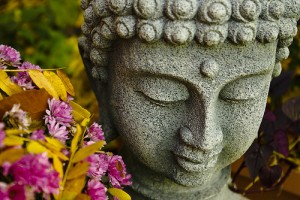 When I was about 15 years old, I had just moved from Montana to the Tempe area and I was doing some deep soul searching. I was finding ways of connecting to a place of peace within myself and learning how tame the monsters in my complicated, teenage mind. One day while walking around Kiwanis park, I stumbled, literally, upon a beautiful, antique looking, gold leafed Buddhist meditation book….which, years later, I intentionally left at the same park, hoping it would fall into the hands of another seeker. It was a significant gift and one that dramatically improved the quality and direction of my life.
When I was about 15 years old, I had just moved from Montana to the Tempe area and I was doing some deep soul searching. I was finding ways of connecting to a place of peace within myself and learning how tame the monsters in my complicated, teenage mind. One day while walking around Kiwanis park, I stumbled, literally, upon a beautiful, antique looking, gold leafed Buddhist meditation book….which, years later, I intentionally left at the same park, hoping it would fall into the hands of another seeker. It was a significant gift and one that dramatically improved the quality and direction of my life.
Up until that point, I never had an official meditation practice, per-say. My practice was more like prayer and journeying based on the teachings and spirituality of native cultures. Meditation and contemplation came with relative ease to me, and believe it or not, it became as much a staple to my rough youth as beer bongs, chain smoking, and breaking curfew. It was always a homecoming, a refuge of peace and it connected me to what I feel is my inner eye, inner Truth and inner calm. It was my own special world, and it could not be violated, laughed at, or judged, it was safe, promising and provided unconditional love.
Eventually meditation led me to yoga and over the years I have continued to submerge myself into Eastern practices in addition to my homeland, spiritual and earth-based practices. I have fallen in love Buddhist Mindfulness/Psychology. In both personal and professional work I have found this approach to be an incredibly insightful, restorative and self-affirming method of therapy and self-realization.
Mindfulness is a practice of gaining awareness and acceptance to the content of the mind, circumstances of life, quality of choices, projections, reactions and attachments. Mindfulness and meditation practices truly can penetrate the layers of toxic and habitual chatter in the mind. They can help reframe your sense of self, your belonging in the world, and your ability to create and live from presence with clear, peaceful perception.
To this day, mediation and mindfulness practices shape my experience of living, learning, parenting, teaching and mind-body therapeutics. Through my dedicated practice the clouded, conditioned layers and patterns of thought and distracting emotions dissipate more and more, and this is a self-sustaining practice that I will most definitely embrace long after my chaturangas and handstands.
As many of you know, I am a lover of the brain and all its wondrous possibilities and mysteries, and I am also deeply curious and dedicated to understanding our psychological processes. Buddhist practices have been directly related to specific functions of the brain/psyche, and below is just a brief example of the correlating attributes. The information gathered is credited to some of my favorite and most influential teachers in the field of Psychology.
Buddhist Mindfulness
(Thanks to Dan Siegel, Jack Kornfeld, Richard Mendius,)
The three main pillars to the Buddhist practice are:
- Virtue: Regulating your actions, words and thoughts to create benefits rather than harms for yourself and others.
- Mindfulness: Involves the skillful use of attention to both your inner and outer worlds. Being mindful simply means having good control over your attention; you can place your attention where ever you want and it stays there, when you want to shift it to something else, you can. Attention is like a spotlight and what it illuminates streams into your mind and shapes your brain. Developing greater control over your attention is perhaps the single most powerful way to reshape your brain and thus your mind.
- Wisdom: Is applied common sense, which you acquire in two steps. First, you come to understand what hurts and what helps. You identify the causes of suffering and the path to its end. Then, based on this understanding, you let go of those things that hurt and strengthen those that help.
Virtue, mindfulness and wisdom are supported by the three fundamental functions of the brain, regulation, learning and Selection:
- Regulation: (associated with Virtue) Your brain regulates itself –and other bodily systems- through a combination of excitatory and inhibitory activity: green lights and red lights.
- Learning: (associated with mindfulness) The brain learns through forming new circuits and strengthening or weakening existing ones.
- Selection: (associated with wisdom) The brain selects whatever experiences have taught it to value.
Developing virtue, mindfulness and wisdom improves the brains ability to regulate, learn and select.
Mindfulness practices emphasize the observer, the quiet witness who is not attached to the thought, action or emotion. The greatest degree of suffering occurs when we attach to those things that do not promote regulation, learning or selection.
Mindfulness encourages one to RESPOND farther than REACT.
Mindfulness practices are rooted in compassion for self and others, love, kindness, forgiveness, surrender and acceptance.
Mindfulness is self-transformation through self-observation.
Blessings, Namaste and Aho,
Robin Afinowich